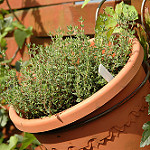Growing Herbs Indoors
Growing herbs in a NYC apartment is not quite as easy as cultivating a garden in the suburbs. Those of us with limited space and little or no access to outdoor gardens need to be selective with what we grow indoors. We’ve put together the perfect list of the best herbs to grow indoors. Pick out your favorites, then click their links to get some simple advice on how to best grow and use these herbs to enhance your life!
Basil
Basil is a sun-loving plant that doesn’t need a great deal of care to thrive. A bit of sunlight, watering, and pruning will get you a wonderful, bushy plant that will provide much flavor to your favorite dishes. This herb is particularly useful for many Italian recipes. Learn more about growing and cooking with basil.
Chives
Looking for an easy herb to grow for your first indoor garden? Chives thrive in small pots, and aren’t very sensitive to temperature fluctuations. Chives add deliciousness to most savory dishes, and are an excellent go-to herb for cooking. Learn more about growing and cooking with chives.
Mint
Looking for the best herbs to grow in low sunlight? Consider growing mint, which loves being out of the sunlight and will grow rapidly and heartily. This versatile herb is great for cooking as well as an addition to refreshing beverages. Learn more about growing and cooking with mint.
Rosemary
If you are looking for an herb that doesn’t need to be watered as frequency, then rosemary is the way to go. Rosemary loves sunlight, though it will survive perfectly well in low-light conditions. The nature of this herb’s structure leads it to prefer to stay on the dry side, so no need to water it too frequently. This herb is delicious with chicken or fish. Learn more about growing and cooking with rosemary.
Sage
Similar to rosemary, sage does very well in dry conditions, and does not need to be watered frequently. It also loves lots of sun, so you can leave it on the windowsill to take in the light and water periodically to keep it fresh. Sage is a very full-flavored herb, so just a little bit will go a long way with your dishes. Learn more about growing and cooking with sage.
Thyme
Thyme is not very sensitive to temperature changes, and it can grow well in small pots, so this is a great herb to grow in small apartments. Thyme is an excellent herb to use in rubs and seasonings. Learn more about growing and cooking with thyme.



